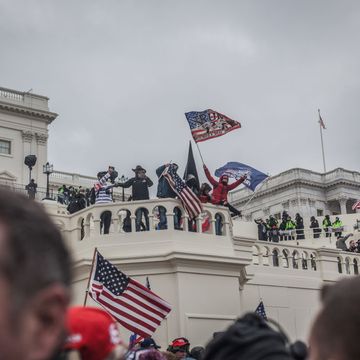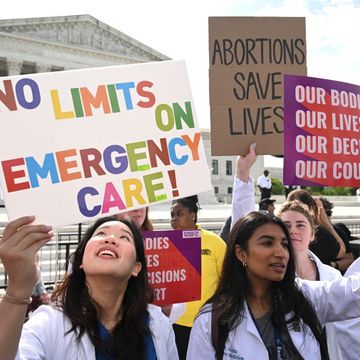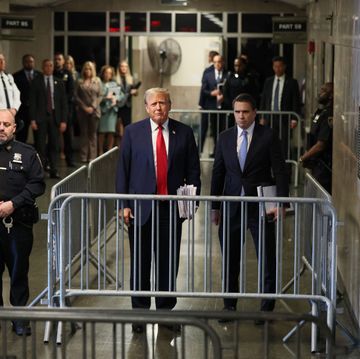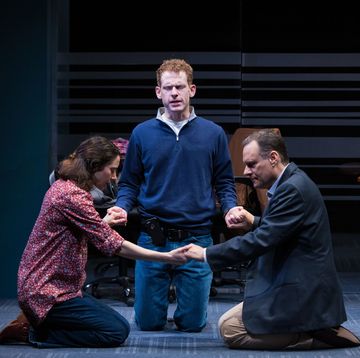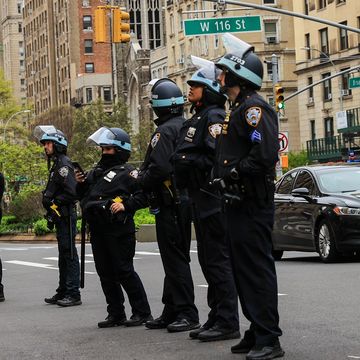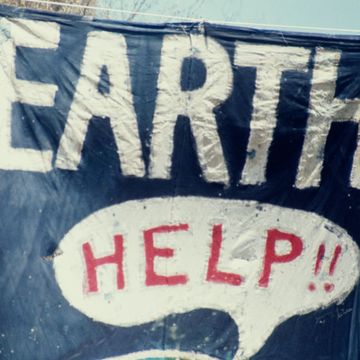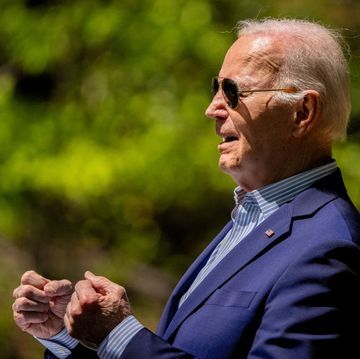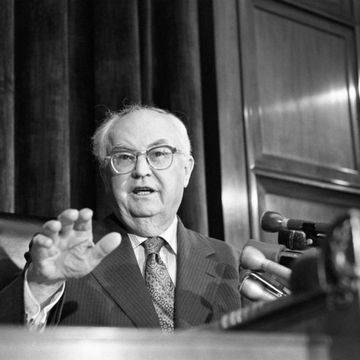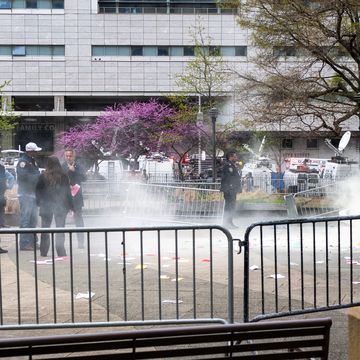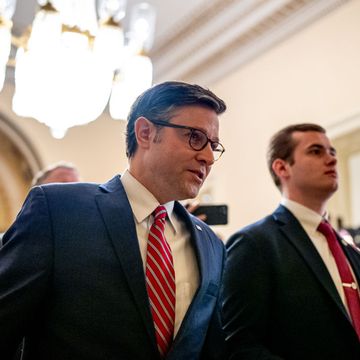As the new World Trade Center One prepares to top out, a look back at the latest in Scott Raab's series "The Rebuilding."
Published in the September 2012 Issue
On this September 11th, 2012, for the first time, no public official will speak at the ceremony at Ground Zero. This may be due to last year's tenth-anniversary event, when the crowd offered George W. Bush a brief yet rousing huzzah and gave Barack Obama the silent treatment. It may be that like the Oscars, the 9/11 commemoration tends to run long, what with the reading of nearly three thousand victims' names, and stilling the pols will save time while offending absolutely no one. New York's mayor, Mike Bloomberg, suggested the names need not be read, since each is etched into the parapets surrounding the memorial pools, but those names, read aloud by friends and family, will echo again across the sixteen acres where they died.
Last year, the Memorial Plaza opened on September 11, the first completed project on the site and one of very few feel-good moments during a decade of rebuilding marred by blown deadlines, public backbiting, and billions of dollars in cost overruns. The plaza finally provided the kin a mourning place, and it also seemed like solid evidence of momentum.
That momentum died not long after last year's ceremony, when the Port Authority of New York & New Jer-sey, led by Andrew Cuomo and Chris Christie, the governors of the two states, stopped paying the contractors trying to finish work on the Memorial Museum, which was scheduled to open on this year's anniversary. Forget the details for now and focus on a simple fact: The Port and the politicians who run it are pigs.
The memorial means nothing to them beyond winning a fight for control of the museum's money and operations — the same fight that every project on the site has inspired.
That has been the underlying and unyielding truth of Ground Zero since September 12, 2001.
This is truly the best reason for dumping the politicians: Ground Zero is not so much a place of remembrance and honor as it is a battlefield. Last year's ceremony featured readings by Obama, Bush, Christie, Cuomo, Rudy Giuliani, and the two sad-sack governors who held office in 2001, New York's George Pataki and Donald DiFrancesco of New Jersey. Pataki is the yutz responsible for nearly all that has gone wrong in rebuilding the site, but they couldn't not invite him. DiFrancesco's connection to Ground Zero was why he fled office: He took a large low-interest loan from a pal he helped put on the Board of Commissioners that presides over the Port Authority. DiFrancesco was not invited to last year's observance until Governor Christie threw one of his many tantrums and Mike Bloomberg agreed to stick DiFrancesco at the bottom of the batting order.
Poor George Pataki: Never the brightest bulb in the chandelier, he once had hoped that the rebuilding might lead him to the White House. So it was understandable that he might be feeling proud — maybe even a little wistful — at last year's ceremony. The dignitaries are assembled by the stage, waiting for Obama and Bush, when one of them overhears Pataki say to Cuomo, "Isn't this a great day? Just beautiful — and look how this has all turned out."
And Andrew Cuomo says to Pataki, "This is the biggest waste of money anybody's ever seen. Who would have ever spent this money? If we'd known what this was going to be like, nobody would have ever done this."
Six bucks buys you a seat on the ferry from the Hoboken train station to Lower Manhattan, but don't sit. Take the stairway to the outside deck and then take a gander — at the "Freedom Tower" (known officially, for leasing purposes, as One World Trade Center) reaching a thousand feet and more up into the morning sky, at the Statue of Liberty due south of Ellis Island, at American History writ huge and stuffed with symbol. Ten minutes across the Hudson River, knitting New Jersey and New York, to the ferry's slip a quick block's walk from the World Financial Center; ten minutes of wind, water, and sun: You could take a PATH train from Hoboken for two dollars and ride under the river in a packed and ill-lit car, but then you'd feel no wind, water, or sun, and none of the awe.
The awe has nothing to do with symbolism. The Freedom Tower's force is its 1,368 feet, exactly the same height as the old North Twin Tower. The building's spire — still being assembled in Canada — will lift it to 1,776 feet. Even now, though — with its top floors yet unclad by a curtain wall of mirrored glass, with two cranes rising with it from its core, waiting to raise that mast piece by piece when it arrives — its naked thrust is knee-buckling.
There will be taller towers in the world when this one is finished — the latest fond hope is early 2014 — but they weren't built atop a mass grave. Their perimeter columns were not sunk seven stories below street level, threaded among the tracks of an active commuter railroad. Those other towers were designed and built by men and women working unburdened by the memory of carnage — and by the certain knowledge that their tower will also loom as a thrilling bull's-eye. Here, a short walk from Wall Street, and at last, it stands nearly finished, an office tower and a pillar whose shadow can't be measured truly by mass alone.
The Freedom Tower's substance — not only the concrete, steel, and glass but the thousands of working folk whose skill and sweat have actually built it — like the sixteen acres of Ground Zero entire, has never seemed to mean as much as its symbolic and economic value to the politicians and the bureaucrats who control it. The land itself is owned by the Port Authority of New York & New Jersey, created more than ninety years ago to manage the movement of goods and people into and out of New York City at a time when there were no major bridges, tunnels, or airports linking the two states. The PA now owns and operates every significant airport, bridge, tunnel, and seaport within a nineteen-hundred-square-mile circle around the Statue of Liberty, with seven thousand employees and a budget — $7 billion this year — funded by the tolls and fees it collects and the bonds it sells, backed by that same broad, bottomless stream of tolls and fees.
The PA is run by a board of twelve unpaid commissioners, six appointed by New York's governor, six by New Jersey's. Traditionally, the board chair is a New Jersey commissioner, and the executive director — effectively the Port's CEO — is selected by the governor of New York. In theory, the idea — a product of the Progressive Era of American politics — was to create a quasi-governmental corporation, self-supporting, free of corruption, and insulated from partisanship.
In practice, the PA has yielded to the surrounding political culture. From 1942 until 1971, the PA's executive director was Austin Tobin, the strongman who built the World Trade Center. More powerful than any elected official, Tobin used the PA's power of eminent domain to seize those sixteen acres and erect the Twin Towers, the world's two tallest buildings when they were completed in 1973, steamrolling the city's private real estate developers, who found it unsporting that a regional transportation agency would flood New York with more than ten million square feet of office space for lease.
Austin Tobin answered only to himself, and his PA was a monolith, omnipotent, opaque. The opacity alone remains; the Port Authority these days is little more than a punching bag, patronage pit, and piggy bank for politicians and those who own or are owned by them. Its stewardship of Ground Zero — in substance and as symbol — has been a bumbling puppet show and an obscene gold rush.
The Freedom Tower, budgeted at slightly more than $2 billion when it was designed, will cost almost twice that price — per square foot, by far the most expensive office tower ever built — primarily because George Pataki saw a vanity mirror, not a construction project. Its finished height, America's nominal birth date — 1776 was the year the Continental Congress adopted the Declaration of Independence — was part of a "master plan" to rebuild Ground Zero handpicked by Pataki in 2003, weeks before he named its centerpiece the "Freedom Tower" and told the world that its steel frame would be topped off by 2006. On July 4, 2004, weeks before New York City welcomed the Republican Convention, he arranged a ceremony to dedicate the tower's cornerstone. Pataki's vision of those sixteen bruised acres was entirely based on the hope that they might serve as his path to the presidency; toting a model of the tower in a custom-made suitcase to Iowa and New Hampshire, he tried to build support for a White House run that was but a fever dream.
Pataki pulled the strings; his PA executive director was an upstate Republican crony, a former town supervisor whose business acumen was honed by running his family's car wash and a bowling alley. When Pataki departed office in 2006, Ground Zero was still a brute void; his cornerstone had been trucked off early one Friday morning. His sole legacy was a new forty-three-story office tower a block north of Ground Zero — the gleaming global headquarters of Goldman Sachs. That baby opened in 2009, complete with a fifty-four-thousand-square-foot gym plus a reading lounge, at a cost of more than $2 billion, underwritten by George Pataki, who handed Goldman $1.65 billion of the Liberty Bonds — pledged by the U. S. Congress shortly after 9/11 to help rebuild the World Trade Center — after the firm bluffed a move to flee New York City and take thousands of jobs with it.
The Freedom Tower's true daddy is David Childs, the architect who designed it seven years ago, back when he was a lad of sixty-four with a mere three decades of experience as a partner at Skidmore, Owings & Merrill, the world's premier corporate architecture firm. His client at the time was Larry Silverstein, a Brooklyn-born real estate developer whose ninety-nine-year lease on the World Trade Center became official six weeks before 9/11. The PA, at Pataki's behest, was getting out of the real estate business; Pataki himself handed over the ceremonial keys to Silverstein, who asked Childs to try to spruce the place up a bit.
After 9/11, Silverstein and George Pataki's Port began a long, nasty war of attrition over control of the rebuilding. It started when Pataki picked a master plan without consulting Silverstein or Childs. That plan — "Memory Foundations" — the brainchild of Daniel Libeskind, an architect who had yet to finish a project taller than four floors, came groaning with slogans and symbolism. Pataki was especially enthralled by a magical "Wedge of Light," described by the bedazzled governor as a "spectacular entranceway to the site, where the sun will shine without shadow [on] the morning of every September 11th.'' Silverstein and his lease — he continued to pay rent of $10 million per month to the PA for a pit full of smoke and debris — were unimpressed.
The wedge idea was dumped due to the fact that a hotel standing across the street would cast its own shadow over it. More crucially, the master plan sited the Freedom Tower where it was most difficult and costly to build. When Pataki refused to move it, Silverstein held fast to his legal right to choose his own architect, and so Libeskind and Childs were forced into a shotgun marriage that was never meant to be.
Libeskind was a critics' darling, a Polish-born artiste who dressed in black and wore cowboy boots. Childs, Princeton-born and Yale-trained, wore suits and ties and had long been loathed by architecture's avant-garde as a developers' pet — guilty of mainstream success, mocked for his modesty.
"I believe in program and function being the forces that create beauty," Childs said when we met in 2005. "They've got to come first. Tall buildings are the result of engineering as much as anything. It's not just an arbitrary sculptural act. There's a lot of architecture that does that, and some of it is very beautiful. But it's not my kind of architecture — and particularly in this case. This building has to be more than a sculptural gesture. We're building an office building. It ought to be iconic and solemn, beautiful and simple — memorable. But it also has to be something that works."
By that time, he and Libeskind had jointly produced a Freedom Tower design deemed unsafe by the New York Police Department, whose concern was ignored by the PA, which has a sixteen-hundred-member police department of its own. At one point, according to Port officials, a letter sent by the NYPD to the PA about the proposed tower's vulnerability to a potential terrorist attack was never delivered, or perhaps lost. When the NYPD finally went public with its worries, the ensuing snafu cost many months and much embarrassment to the PA and Pataki — and left David Childs in charge of the Freedom Tower's final version.
Childs is seventy-one now. He works fewer hours, travels less, and isn't wearing a tie. He watched from a window in this Wall Street office as the Twin Towers fell eleven years ago. SOM lost one employee that morning, a forty-five-year-old architect calling on a client at the World Trade Center.
"I used to walk over there and look at the site and think about it. People would go in and look down and it was sad. Now they go and they look up and they're smiling. There is this piece that says, 'We did it' — and that's what that tall tower is. People fly over it, they drive, they come across on the ferry and they look at it and they feel good. They smile. I feel good about that. We came back and we rebuilt it, and we should feel good about it."
He himself sounds unconvinced. Worn-out. That would be understandable if so: Less than a year after his final design for the Freedom Tower was approved, the long ongoing war between Larry Silverstein and the Port reached a temporary detente, and a deal was struck: Silverstein would build three smaller office towers on the WTC site, but not the Freedom Tower. That belonged to the Port Authority again.
Childs is disinclined, by nature and professional diplomacy, to detail the resulting woe. Long story short: Pataki begat Eliot Spitzer, the Emperors Club VIP's whoremonger, who campaigned and took office harrumphing about killing the tower, changed his mind a month later, and resigned after little more than a year as governor, so foully disgraced by his penis that he recently was forced to seek refuge in Al Gore's wing-nut protection program, Current TV. Spitzer in turn begat Blind David Paterson, who confessed his own philandering one day after his inauguration. And Paterson begat Andrew Cuomo, the current governor.
Each had his own political agenda; each appointed a PA executive director of his very own; each viewed the World Trade Center rebuilding — and the Freedom Tower above all — as a redheaded stepchild. As the estimate for completing the tower rose past $3 billion, the PA struck a deal in 2010 with a city real estate developer, the Durst Organization, to help finish, manage, and lease the tower: For $100 million, Durst received a 10 percent equity interest in the building, plus a $15 million management contract that gave Durst 75 percent of any monies saved by cutting construction costs up to $12 million, and a mere 50 percent of every penny cut thereafter.
To nobody's surprise and David Childs's despair, Durst found costs to cut, particularly at the top and bottom of the tower. The prismatic glass chosen to wrap the base of the building was replaced with a cheaper version, requiring that the corners of the tower's first two hundred feet be squared off after those corners had already been tapered to meet the thousand-foot isosceles triangles of the curtain wall. Then Durst took its meat-ax to the tower's 408-foot spire: By simply scrapping the radome — a sculpted shell of fiberglass and steel designed to sheathe the antennae and maintenance platforms atop the building — shazam! $20 million saved.
Childs learned from a Durst press report that the radome had been whacked, and issued a statement expressing his disappointment and his hope that SOM and the Port could find an alternate design. Durst claimed its radome decision was strictly about maintenance cost and safety, not money. Patrick Foye, current PA executive director, agreed, adding, "What was designed was impractical, unworkable, and quite frankly dangerous."
Considering that SOM has somehow managed to build and create maintenance plans for skyscrapers in many places for many years; and considering that Douglas Durst himself paid to place full-page ads in New York City newspapers in 2007, urging the new governor, Eliot Spitzer, to murder the tower; and considering that without the radome, what was a spire may be discounted as an antenna mast by the Council on Tall Buildings and Urban Habitat — the arbiter of building heights — which would mean that the Freedom Tower won't officially stand 1,776 feet tall: Regarding all this, David Childs is mum. Circumspect. Or plain worn-out.
"The simple, pure form — I'm proud of that," he says, and falls silent.
PATH stands for Port Authority Trans-Hudson, the railroad winding seventy feet below the World Trade Center site, carrying commuters to and from New Jersey at a loss of almost $400 million per year. When it started running in 1908, it was the Hudson & Manhattan Railroad and turned a profit. Then the PA built the Holland Tunnel, which opened in 1927, the very year Austin Tobin joined the PA's law department, followed by the George Washington Bridge, opened in 1931, and the Lincoln Tunnel, in 1937. Soon the old H&M was running deep and forever in the red; thanks to the PA's devotion to the automobile, its ridership plummeted from 113 million in 1927 to only 26 million in 1958.
As the H&M sank into bankruptcy in the fifties, New Jersey asked the PA to take over its operation. The logic seemed solid: The railroad was a crucial regional transportation link, and the Port Authority's purpose was to manage the region's transportation fairly, and the PA had clearly destroyed the railroad. Austin Tobin preferred not to, strongly, and his logic, while entirely self-serving, made sense: The PA had never been in the railroad business or in the business of losing money.
Grasping these few simple facts of regional history is fundamental to fully comprehending the economic and political calculus of rebuilding Ground Zero. They explain why the PA is still viewed — by New York and New Jersey, and by bond traders, too — as a fount of infinite wealth: Even at the Great Depression's nadir, the Port Authority was proudly swinging its money and might like a cudgel. They also became the bedrock of northern New Jersey's belief that the PA is and always will be biased toward New York City, a faith fortified daily for New Jersey commuters, who pay a twelve-dollar cash toll to motor into Gotham through the Lincoln or Holland or over the GWB, while their ride home is free — not exactly a token of respect and equal standing.
And so it came to pass that when Austin Tobin began dreaming of a World Trade Center in Lower Manhattan, he chose a spot near the East River, inaccessible to commuters riding the H&M. And when he sought the necessary approval of the governor of New Jersey, New Jersey told Tobin to go pound salt, and, like Tobin with the H&M, refused to budge.
And so Austin Tobin — less famous than Robert Moses but every ounce as determined to create monuments to himself — made New Jersey an offer too sweet to refuse: The Port would buy and maintain the H&M, spend an immediate $70 million to upgrade it, and move the WTC site west, to the Hudson River side, right where the H&M's Lower Manhattan terminal stood.
Which solves at least one Ground Zero mystery:
Why is the Port Authority building a new PATH hub there that will cost around $4 billion by the time it's finished?
Because that's part of the price the PA paid to persuade New Jersey to say yes to the entire project. But only a part.
And it really begs a much tougher question:
How in the world can an eight-hundred-thousand-square-foot transit station cost $4 billion?
Amazing, no? The Freedom Tower, which will offer tenants 2.6 million square feet of office space — and which has been fortified against any future attack by means and material of unprecedented scope and expense — will end up costing the same, give or take, as the PATH hub. And not — as they like to say in the Garden State — for nothing. Because from day one — years before the Port pried the Freedom Tower loose from Silverstein — this was to be the PA's Golden Fleece, in every sense, the only construction project on the sixteen acres that would give, and give, New Jersey ample opportunity to freely, fully wet its beak.
It was always meant to be wildly expensive: It was initially budgeted for $2 billion, with the entire bill footed by the Federal Transit Administration. So the PA commissioned a starchitect of the first order, Santiago Calatrava, to design it — many folks still refer to it as "the Calatrava" — and the much-loved Spaniard designed the hell out of it. His central hall began fifty feet below street level, a vast ovoid beneath a soaring dome of glass and steel — Calatrava called it the Oculus — ribbed by narrow white arches, curving as they rose and reached beyond the building walls, like the fingers of clasped hands.
But there was more — much more. Calatrava sketched the hub as a bird taking flight from a child's hand and designed the dome roof to retract mechanically — he was also a civil engineer — so that its arches would seem like spreading wings as the roof opened.
"This is the Port Authority's gift to New York City," said Calatrava.
All of New York said thanks, including architecture critics. "With deep appreciation," wrote Herbert Muschamp of The New YorkTimes, "I congratulate the Port Authority for commissioning Mr. Calatrava, the great Spanish architect and engineer, to design a building with the power to shape the future of New York."
Our pleasure, said the Port Authority, perhaps especially pleased that nobody seemed to notice that its $2 billion jewel of a PATH hub would serve about 50,000 commuters daily, a sliver of Penn Station's 600,000 or Grand Central's 750,000 — and that no one was unkind enough to mention how much money the PA was already losing on the railroad each and every year.
"I have become very, very fond of Santiago," said Pataki's Port Authority executive director, who'd come a long way from his upstate car wash and bowling alley. "The guy's a genius. But the first thing that hits you in the face — he gives you a hug."
Never let it be said that New Jersey guys won't hug back — or that they're foolish enough to look a New York City gift horse in the mouth. On the Federal Transit Administration's $2 billion dime, the PA had hired the so-called "poet of transportation architecture," Calatrava — try saying it aloud; it fairly dances off the tongue — and he had poured out his ode of concrete, steel, and glass, and everyone had sung hosanna.
There was some concern, of course, about constructing the actual building. Those wings might prove tricky, the dome's expanse of exposed glass could pose a security risk — given the dark attraction of Ground Zero — plus the hub's specific location meant that much of its below-ground ceiling would also be the floor of the yet-to-be-built Memorial Plaza, not to mention that one of the wings, when spread, would come perilously close to a yet-to-be-built office tower next door.
How fortunate, then, that two of the Port's New Jersey guys, commissioner Anthony Sartor, who chaired the Port's World Trade Center subcommittee, and Anthony Cracchiolo, the PA's director of Priority Capital Programs, made time for a trip to Europe to study some of Calatrava's finished work. Even luckier: Like Calatrava, both men are engineers and so were able to offer professional assurances, after completing their tour, that there was no need to worry — Calatrava's hub construction would be smooth sailing.
Construction of the PATH station began on September 12, 2005, and was officially scheduled for completion in 2009. Calatrava came to the groundbreaking ceremony with his ten-year-old daughter, Sofia, who released two doves into the morning air. Officially, according to the Port, they were doves. Truth is, they were homing pigeons.
By July 2006, Federal Transit Administration consultants keeping tabs on the hub were already telling the FTA that the project was being crippled by constant design changes and would take far longer and cost much more to complete. Every three months, the consultants issued another update reporting problems with design, scheduling, and oversight.
In early 2007, the PA admitted the hub's cost could climb to $2.5 billion. In May 2008, the Port stuck to that figure, and Commissioner Sartor vowed that it "will be completed and functioning in 2011," noting that the PA was "working collaboratively" with Calatrava on design changes to ensure it would be so.
The conflicted extent of that collaboration became news a few weeks later, when it came to light that STV, one of the firms that was working with Calatrava on the hub — and on other Ground Zero projects — was also in talks to purchase an engineering company that Sartor ran. Sartor and the PA denied any conflict of interest, although it certainly looked bad: STV was part of the Downtown Design Partnership, a joint venture that included Calatrava.
Not to worry, said the PA: Sartor — did I mention that he also chaired the Port Authority subcommittee in charge of rebuilding the World Trade Center? Or that STV's New York City office was located in the same office tower as the PA's headquarters? Or that STV made a habit of hiring former PA employees, like Tony Cracchiolo, the PA official who went to Europe with Sartor to see Calatrava's work, and who joined STV in 2006 as senior vice-president and director of design, taking with him a six-figure Port Authority pension?
Where was I? Oh, right — no worries, said the PA: Commissioner Sartor had notified the Port of the STV negotiations to buy the engineering company he ran, and had recused himself from all PA votes related to STV's work on the site.
Not that Sartor's recusal mattered: Every PA board resolution for at least the prior two and a half years — including contracts totaling nearly $400 million awarded to the DDP and STV for work on the PATH hub and other Ground Zero projects — had already been approved. Unanimously.
By then — May 2008 — most folks had stopped paying attention to the sixteen acres of quicksand at Ground Zero. George Pataki was long gone, Eliot Spitzer had resigned in mid-March, the Great Recession was looming, and all of the lip service paid to remembrance, rebuilding, and resilience in the wake of 9/11 had long since curdled into a cover story for business as usual. But on May 22, another PA executive director took over, picked by Blind David Paterson, Spitzer's successor — and the new PA guy, Chris Ward, did something odd and wonderful right away: He called bullshit, publicly, in detail, on all the prior Ground Zero budgets and timetables, which everyone knew to be bullshit anyway.
By the end of June, Ward had issued a thirty-four-page study outlining the major problems — the PATH hub foremost among them: the PA still didn't have a final design for the Calatrava — and told the governor he'd need three months more to establish realistic schedules and budgets for rebuilding, and created a cross-project governing board to coordinate planning across the whole sixteen acres.
And by so doing, Chris Ward almost rescued the rebuilding.
Almost.
Ward was no Austin Tobin — although he put a photo of Tobin on his office wall — and the PA no longer housed the corps of engineers and project managers that built the Twin Towers. But Ward had the governor's support and two huge advantages: He was perfectly suited for the job, and he had no illusions about how tough it would be.
A New Jersey guy by birth and a professional New Yorker, Ward had done time as a PA senior executive from 1997 to 2002, and as a commissioner of the city's Department of Environmental Protection, managing director of the General Contractors Association of New York, and CEO of American Stevedoring, he knew firsthand how the public and private sectors worked and why they often didn't work, together and separately. He also had a graduate degree from Harvard Divinity School, which may have been of no particular use as Ground Zero's near-savior, but which nonetheless made him seem exotic in the context and appealed to anyone writing about him as an irresistibly telling detail.
Given the interlocked infrastructure of various rebuilding projects — the PATH hub, the Memorial Plaza and Museum, and Larry Silverstein's proposed towers in particular — what Ward managed to get done during three and a half years as executive director was impressive. Given the long-fractured nature of the relationships among the warring parties — and the image of the Port as a stooge act and of the rebuilding as a failure — Ward worked miracles.
He forged peace with Silverstein and worked out a financing deal on the developer's other Trade Center towers. He helped broker a long-term lease for a million square feet of Freedom Tower office space with a prestige publisher. He persuaded the PA Police Department to let the NYPD, a vastly superior force, provide security for the Trade Center. Mano a mano, he prevailed upon Santiago Calatrava himself to make PATH hub design changes that would save $600 million and speed its completion.
In short, Chris Ward was the prime mover in turning those sixteen acres around. And by doing so, he gave the PA itself new life and restored its sense of competence. His crowning achievement, and the Port Authority's, came on September 11, 2011 — the tenth anniversary of the terrorist attacks — when the Memorial Plaza opened. Finally, the victims' families could come and stand at a place commensurate with their grief. Finally, something beautiful — something honorable — got done at Ground Zero.
By then, though, Ward was a dead man walking.
"In a funny way, David Paterson was the right governor during that time period. He didn't see himself as defined by downtown. When he hired me, he said, 'Just get it right and I won't bother you,' and then he backed me up. It was clear — the Port Authority was running downtown. If you wanted something done, if there was an issue, it fundamentally had to go through one place."
Ward's sitting in a conference room at his midtown office; he's executive vice-president for major projects at Dragados USA, a subsidiary of an international construction firm based in Spain. Down the road, if the firm bids for some PA work, he'll abstain from the process. Strictly business — not that he doesn't still feel connected to Ground Zero and his work there.
"I'll always be defined, and I will define myself, by those three and a half years. No doubt about it."
That's about the limit of Chris Ward's sentimentality. Business is business. He knew his days at the PA were numbered after Andrew Cuomo became governor in 2011 and ignored Ground Zero completely. Cuomo saw no upside for himself downtown — just a PA executive director making decisions, getting public credit. There were no meetings, no phone calls, no e-mails between the two about Ground Zero. When the press asked about it, the governor's office issued a statement saying he had no plans to replace Ward "at this time." Of course not: If he got rid of Ward before the tenth anniversary of 9/11 and anything went wrong with the race to finish the Memorial Plaza, Cuomo would rightly be the fall guy. But with those three words — "at this time" — Cuomo declared what most insiders already knew: It was now open season on Chris Ward.
That much had already become clear when, at a PA Board of Commissioners meeting soon after Cuomo took office, Tony Sartor — whose STV deal had died a quiet death soon after it became public — responded to another hike in the price of the PATH station by telling Ward, "I would like to get a true assessment of what the costs are going to be, for the hub and the rest of the project," as if Ward were the one who'd sired the Calatrava and then blown smoke for seven years about its costs and construction.
Any plausible doubt about Ward's doom was sealed when New York City's mayor, Mike Bloomberg, asked Cuomo personally to let Ward finish the job of rebuilding the World Trade Center.
When I ask Ward about that, he laughs.
"The mayor joked, 'You know, I probably cost you your job because I said twice what a good job you were doing.' "
Cuomo owed Bloomberg nothing, and Bloomberg, a lame duck, had no leverage. The mayor's Ground Zero interest was limited to the Memorial Plaza and Museum; the plaza was rushed to completion after PA engineers found a way to build it even though the plaza itself would also form a part of the roof of the unbuilt PATH hub, and the museum was supposed to open on 9/11/12. Bloomberg's fear was that if Ward left, the museum would be orphaned.
Appointed Port Authority executive director in May 2008, Chris Ward took a site mired in politics, cost overruns, and inexplicable delays and at last the towers began to rise. His good work got him shoved aside by Governor Andrew Cuomo last year.
That's precisely what happened. With Sartor leading the way, the PA started threatening to shut down funding for the museum if the museum didn't pay a larger share of the infrastructure costs. Ward had suggested negotiating the difference to keep the museum on schedule and avoid yet another cycle of Ground Zero woe. To no avail: With Ward out of the way, the PA's negotiating tactic was simply to stop paying contractors to finish the work, and to blame Ward for poor management and playing politics with the Port Authority's money.
How much money? Depends on who you ask. Chris Ward believed it boiled down to no more than $50 million, tops. Anthony Sartor said $150 million — petty cash compared with a PATH hub overrun climbing toward $2 billion on a project that he promised could be finished for 2.5. But it was Sartor's New Jersey colleague, PA commissioner David Steiner, who reminded everyone that the Calatrava — not the Freedom Tower, not the Memorial Museum — was Ground Zero's true icon. And so the Memorial Museum won't be ready as promised, and nobody knows when work on it will resume. But it's a safe bet that once Mike Bloomberg leaves office — and Andrew Cuomo will be able to take credit for riding to the rescue — another bargain will be struck with the New Jersey boys.
"We're gonna go back to that kind of world?" Chris Ward says now. "I thought we'd gotten rid of that when we said, 'Let's just get it done.' It would unfold, and its story would be told and retold. Until you finish it, you're never going to have that story. And now? Now you're back to fighting.
"The Port Authority is one gigantic business negotiation that goes on forever and never ends — there's always a transaction going on. And the only way to lead the Port Authority is by understanding that."
The truth about Ground Zero is that nearly three thousand people died here and millions of visitors have already come to the Memorial Plaza and stood at the reflecting pools and seen their names and carried away stories that have nothing to do with politics and plunder.
The palpable truth about Ground Zero is inscribed upon these sixteen acres each day by the men who work here.
Mike Pinelli and Marc Becker have been here from the start, supervising the Freedom Tower's construction. The politics mean nothing to them, nothing worth saying.
"I know it's gonna happen," Marc Becker said in 2005, standing at rock bottom of the empty pit, where construction had stopped dead before it ever really got started. "I just don't know when. It's very personal to me — I saw what the poor souls looked like after they jumped out of the buildings. What they pulled out of the debris, I saw it. It's personal. We're ready to go. We're ready to build."
Pinelli came home after 9/11 and found himself sitting dazed, in tears, trying to explain to his three young girls what had happened when his middle daughter told him to buck up.
"Everything's gonna be all right. You're gonna put it back up again. Your job is to put things back up."
She was five years old then. She'll turn sixteen in a couple of days, Pinelli says. His oldest is seventeen now.
"To this day they talk about it," he says. "They follow the progression of the building closely. They get excited, their friends are excited."
Pinelli and Becker are both New Jersey guys. Pinelli's dad retired as a Port Authority cop. The Freedom Tower, it's still personal.
"Every day we come to work at sacred ground," Pinelli says. "We have that in our hearts. It never leaves."
"Pride and honor," says Becker.
Pride, honor, and duty.
"The job is a marathon," Pinelli says. "You break it down in pieces. Set milestones. For myself, for my team. When you hit a milestone, you celebrate a little bit, circle the wagons, and start back up. It was a big accomplishment to finish the foundation. The core was a bear — the sheer volume of the concrete core. Then the push to get the building into a one-week cycle. Next week we're going to top out 105.
"The antenna's going to be here in the fall. The interior work, the MEP systems — the backbone of the building — are all coming together. Third or fourth quarter. 2013, we'll be right there."
"The antenna will be the exciting part," Becker says.
"Marc's trying to figure out a way to climb it. He's working out."
No shit.
"I've actually started running again," Becker says.
He's fifty-four now, Becker. An ox. But don't bet against him taking a piss off the top of the Freedom Tower. He was out to dinner with friends Saturday night down the Jersey Shore — Sandy Hook, forty minutes by ferry from Manhattan — and looked out the window and saw it shimmering across New York Harbor and started texting photos to Pinelli.
"Look who I'm having dinner with," Becker says, laughing. "Our baby."
Pride and honor.
"That's the truth."



